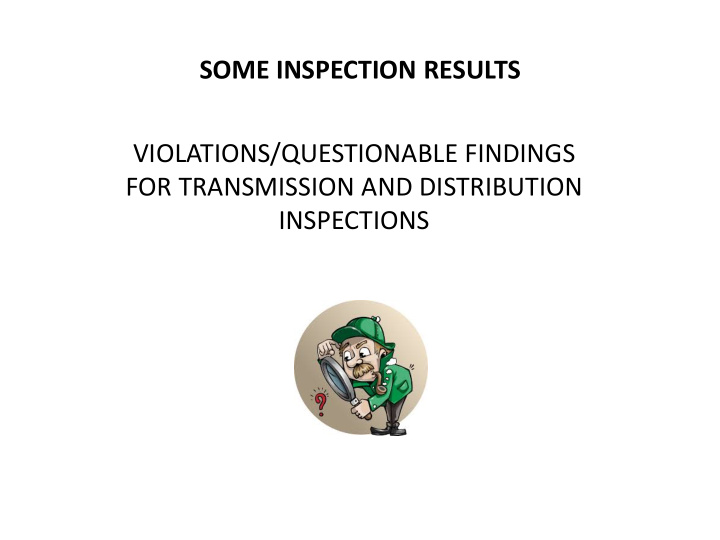



SOME INSPECTION RESULTS VIOLATIONS/QUESTIONABLE FINDINGS FOR TRANSMISSION AND DISTRIBUTION INSPECTIONS
CODE REGULATIONS Transportation of natural and other gases by pipeline Part 191: Annual, incident, safety-related condition reports – 16 Sections. • Part 192: Minimum Federal Safety Standards – 137 Sections, 4 • Appendices, Numerous IBR standards. Part 199: Drug and alcohol testing – 36 Sections • – DOT procedures, Part 40, numerous sections. Chapter 25-12: PSC’s natural gas safety rules – 34 Rules • All have subsections. • 2
Overall, there are many rules to comply with. It is not an easy job but • compliance is important to ensure that the pipe is being designed, operated, and maintained safely. 3
It is our job to ensure that companies are complying with the rules. Some areas that needed more attention. 4
TRANSMISSION INTEGRITY MANAGEMENT DOCUMENTATION, DOCUMENTATION, DOCUMENTATION • 5
How does an operator identify a high consequence area? – 192.905 • Imp. Program does not describe method used to identify HCA. • Wrong nominal pipe diameter used in the PIR formula, 14 inches and above pipe size is the same as the nominal diameter. • No documentation to show that public officials were contacted about identified sites. • No documentation to show that the pipe is periodically evaluated for the presence of new HCAs. What is a continual process of evaluation and assessment to maintain a pipeline’s integrity? – 192.937 • No interval set and no documentation to show that a periodic evaluation was done. What are the elements of an integrity management program? – 192.911 • Inadequate provisions in the communication plan for addressing the safety concerns of PHMSA and the FPSC. 6
What are the requirements for using External Corrosion Direct Assessment (ECDA)? – 192.925 • Insufficient number of digs for a first time assessment. • If no indications or only monitored indications – 2 minimum + 2 post- assessment digs. • Additional digs for immediate indications. • Additional digs per region for scheduled indications. • Direct examination requires excavation and measurements on the exposed pipe. • No separate region defined for underwater sections of pipe. • Direct examination not conducted on pipe in casings or under water crossings. • Inadequate documentation of procedures for indirect inspections over water and pavement. 7
What additional preventive and mitigative measures must an operator take? – 192.935 No documentation of a risk analysis for adding automatic shut-off • valves or remote controlled valves . What records must an operator keep? – 192.947 Implementation of the program differs from written plan and • no documentation was made to explain why. What actions must be taken to address integrity issues? – 192.933 Line is operating at greater than 20% of maximum pressure • experienced on the date of discovery of an immediate repair condition. 8
WHAT DO YOU THINK? Is adequate care being taken in handling the pipe? 9
10
11
External corrosion control: Protective coating. - 192.461 Pipe was being pulled into the ground. 1. Coating damaged and not repaired. 2. After being notified to repair the coating, repairs were done without preparing the pipe properly.
A concern. Thin Spot in Coating. There is less coating protection than what is marked on the pipe. 13
COVER - 192.327 Main installed with less than 24 inches of cover. 14
Belowground emergency valve 15
Regulator pit 16
Aboveground regulator station 17
ATMOSPHERIC CORROSION CONTROL: MONITORING/GENERAL - 192.481/192.479 1. For the underground pipes: We are unable to inspect for atmospheric corrosion on the pipe surface. 2. For the regulator station: Corroding pipe must be cleaned and coated to provide protection against atmospheric corrosion. 18
LINE MARKERS 19
LINE MARKERS 20
LINE MARKERS FOR MAINS AND TRANSMISSION LINES - 192.707 • No area code or wrong area code. • Did not include the word “Warning,” “Caution,” or “Danger.” No operator name. • Marker information obscured. 21
PIPE USED FOR REPAIRS 22
MANUFACTURED DATE 23
INSTALLATION OF PLASTIC PIPE - 192.321 Pipe in back of truck is 5 years old. How long has it been exposed to ultraviolet rays? The rule has a maximum of two years. 24
BUTT FUSION 25
BUTT FUSION 26
PROCEDURAL MANUAL FOR OPERATIONS, MAINTENANCE, AND EMERGENCIES – 192.605 The operator has to follow its written procedures. In this case it adopted the manufacturer’s fusion procedures. The fuser did not execute the procedures properly, resulting in a butt fusion that failed visual examination. 27
GAS INTERRUPTION – VALVE SHUT 28
INTERRUPTION OF GAS SERVICE - 25-12.044 • Meter valve shut but not locked. 29
IDENTIFICATION 30
FACILITY IDENTIFICATION - 25-12.050 • Faded or missing operator name and phone number. 31
PRESSURE RECORDER 32
PRESSURE LIMITING AND REGULATING STATIONS: TELEMETERING OR RECORDING GAUGES - 192.741 A distribution system supplied by more than one district pressure regulating station. Non-recording recorder 33
REQUIREMENTS FOR DISTRIBUTION SYSTEM VALVES – 25-12.022 VALVE MARKING 34
Marked for prompt identification Durable tag or other equivalent means Legible marking Marked on a permanent material Placed in a visible location Not marked on the cover only 35
QUESTIONS? 36
Recommend
More recommend